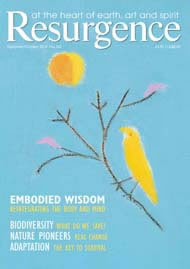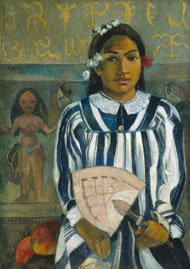In 1923 Picasso said to Marius de Zayas; ‘…Art is not truth. Art is a lie that makes us realize the truth, at least that truth that is given us to understand.’
If we accept this important statement then it may go some way to support the necessity of exaggeration in Gauguin’s work; it underpins aspects of his visionary style but it does not support his tendency to fabricate.
He was a maker of fables. He exploited his relationships with the indigenous people of Tahiti and veered between stark, racist attitude and trying to incite rebellion amongst the native people with whom he chose to live against the colonialists who had been quick to ostracise him.
His paintings grasp wildly at imaginative narratives. They utilise misunderstood, appropriated fables and drift into filleted mythology. He left France purposefully seeking sensuous years of maturity and a means to reinvigorate his work. He did find this in Polynesia but the question that remains is whether the work is heart felt and progressive.
Does it, by Picasso’s measure, lead us to ‘…realise the truth’?
Despite the fact that some artists can be awkward, disturbed, egocentric and totally reliant on the support of others, the truth that Picasso was talking about can still sometimes shine through in their work. It is as if their art is able to transcend rather than reflect the negative aspects of their lives. Among such artists as these Gauguin’s reputation has been subject to myth making.
His friend and first biographer Charles Morice has been joined by a swathe of others who followed in an almost unchallenged bid to make Gauguin a heroic figure. According to these he lived a life that confronted the hypocrisy of his class and his Nation.
Gauguin had been somewhat successful in Paris and his adoption of ‘primitivism’ actually took place in Brittany not in Polynesia, as examples of his paintings of the 1880’s make clear. The Yellow Christ, The Breton Calvary and The Potato Field divide the subjects and the landscape into broad planes reminiscent of Japanese woodblock prints and their bright, off-key patchworks of colour ensured a slightly haunted but decorative result.
When later he decamped to Polynesia his treatment of the natives was exploitative. He tried to absorb a rich Tahitian culture within the bounds of his synthesised style but the Tahitian words in the titles of these works show a lack of understanding of proper spelling and grammatical context. In effect, he consciously developed a stance that he felt would enrich his work and lead to intrigue in his ‘radical’ style and ‘visionary’ perception.
Paul Gauguin arrived in Polynesia on 12 June 1891. His arrival was recorded by his friend Jenot: “As soon as Gauguin disembarked (at Papeete), he attracted the stares of the natives, provoked their surprise, and also their jeers…..his long, salt and pepper hair falling in a sheet on his shoulders from beneath a vast, brown felt hat with a large brim, like a cowboy’s. As far as the inhabitants could remember they had never seen a man with long hair on the island…Gauguin was renamed ‘taata vahine’ (man-woman), which the natives made up ironically…’
His new name in Tahitian translates as transvestite and it was meant to mock him. He came to Tahiti with the Breton paintings and ceramics behind him. These were works in which he had celebrated what he felt was the Breton naivety and their people’s commitment to spiritual myth.
Once hooked on this search for the depth of strangeness in other cultures Gauguin was caught up in constantly rejecting sameness and a relentless search for the more and more exotic. In his autobiographical novel Noa Noa Paul Gauguin describes the move from Papeete to Mataiea. It was probably a move to take him further from a place of colonial power as his search for the exotic and the erotic
In Avant et après (1903), Gauguin suggested that: “The syphilitic and the alcoholic will perhaps be the men of the future. It looks to me as if morality, like the sciences and all the rest, is on its way to quite a new morality which will perhaps be the opposite of that of today.”
Gauguin took lovers amongst the native women but he never gained the respect of the indigenous people with whom he tried to live. In his last years in the Marquesas he was something of a figure of fun. The people neither respected his art nor understood the peculiarity of his dress and what they felt was his rather indeterminate sexuality.
In his painting Primitive Tales (1902), the gruesome portrayal of his friend Jacob Meyer de Haan sits isolated and ignored by the two Marquesian beauties. They are turning their backs on him and there is a sense in which de Haan could be an older, raddled version of Gauguin as he had portrayed himself as Christ in the Garden of Olives (1889).
Despite these reservations and criticisms the large survey of Gauguin’s paintings, drawings ceramics and sculpture which will be shown at the Tate Modern in London between September 30th and 16th January will show the strength of his design and the way in which his contribution helped to develop the impressionist movement into something that embraced symbolism and exoticism. The structure of his compositions could be strong. He and Van Gogh were indebted to one another in mutual influence. They both developed separate, haunting colour sense.
There has not been a major exhibition of his work on such a scale for 75 years and such a massive undertaking means that the gap until the next survey of this kind is likely to be just as long. Though he was a flawed and arrogant man Gauguin did produce some work that pushed boundaries and is of great quality. His autobiographical stances are seldom to be believed. He was unable to quite rid himself of the prevalent colonialism and racial attitudes of his time. He adopted cultural significance that was not his own really lived experience but he did make a contribution to art which is both singular and of value.








